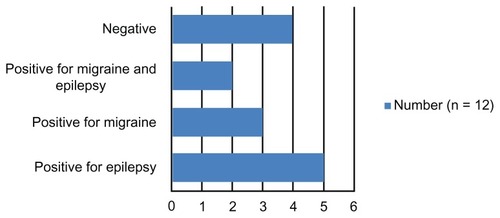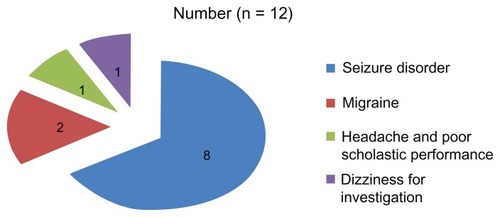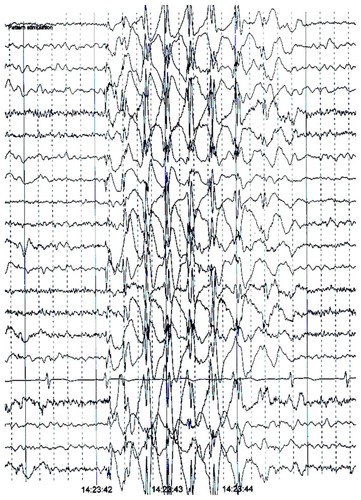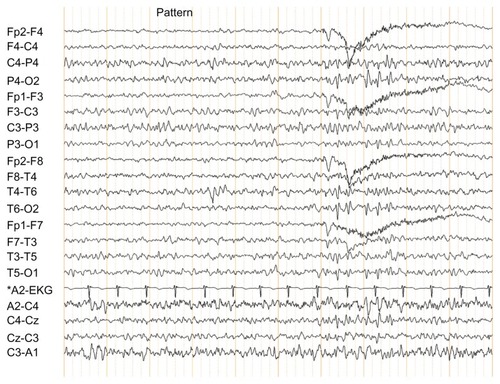Abstract
Rationale
Pattern sensitivity can be diagnosed by presenting a series of visual patterns to the subject in the electroencephalography (EEG) laboratory; however, testing for pattern sensitivity is not routinely done during EEG recording. This work aimed to highlight the incidence of pattern sensitivity among patients referred for routine EEG recording during a 1-year period, identifying the cause of referral, diagnosis, and the characteristics of pattern-sensitive patients.
Methods
All patients aged 4 years and older who were referred for routine EEG during a 12-month period and had no motor or visual impairment were enrolled in the study. Intermittent photic stimulation and pattern sensitivity were tested for each case. Pattern sensitivity was tested by scanning three different rhythmically moving patterns at reading distance with the patient seated in an illuminated room. A pattern evoking a paroxysmal response was reintroduced after exposure to a blank white card to confirm the findings.
Results
Two hundred twenty-eight patients were studied; twelve patients (5.26%) had pattern sensitivity and their ages ranged from 5 to 12 years. Eight of these patients (66.7%) were referred for seizure disorders, two were referred with the diagnosis of migraine, one with headache and poor scholastic performance and one with recurrent attacks of dizziness for investigation. Seven of the twelve patients (58.3%) had a previous EEG done without testing for pattern sensitivity. Five patients (41.6%) had positive family history for epilepsy, three (25%) for migraine, and two (16.6%) for migraine and epilepsy. Two patients (16.6%) had pattern sensitivity without photosensitivity. Pattern stimulation provoked epileptiform discharges in eight patients (66.6%), focal discharges in one, and unilateral build-up of posterior discharge in three.
Conclusion
Diagnosis of pattern sensitivity is often missed as it is not routinely tested for during EEG recording. The result of the study challenges the concept of a consistent association between photosensitivity and pattern sensitivity; it also raises questions about the incidence of pattern sensitivity among children who do not suffer from epilepsy and in particular those with migraine, headache and scholastic difficulties. Further studies are therefore needed to clarify the phenotypic spectrum of this EEG trait.
Introduction
Pattern-sensitive epilepsy is a form of reflex epilepsy in which seizures are precipitated by visual patterns, typically stripes.Citation1 Because of the close association between sensitivity to intermittent photic stimulation and sensitivity to visual pattern stimulation, pattern-sensitive epilepsy has been commonly regarded as an extension of photosensitive epilepsy.Citation2,Citation3 However, the diagnosis of pattern sensitivity in a photosensitive patient is of clinical importance as it shows the additional range of visual stimuli to which the patient is vulnerable. Seizures in pattern-sensitive patients may be induced while viewing environmental patterns such as window screens, tablecloths, ceiling tiles, escalator steps, striped wallpaper, and clothing.Citation1,Citation4 Absences, often associated with eye blinking, facial contractions, and myoclonic jerks of the upper extremities, are the seizure types typically evoked by the pattern exposure.Citation3,Citation5 However, generalized tonic clonic seizures and less frequently partial seizures may occur; the latter may be confused with migraine.Citation1
Pattern sensitivity can be diagnosed by presenting a series of visual patterns to the subject in the electroencephalography (EEG) laboratory; however, testing for pattern sensitivity is not routinely done during EEG recording.
This work aimed to highlight the incidence of pattern sensitivity among patients referred for routine EEG recording during a 1-year period, identifying the cause of referral, diagnosis, and the characteristics of pattern-sensitive patients.
Patients and methods
All patients aged 4 years and older who were referred for routine EEG during a 12-month period, who had no motor or visual impairment, and whose parents agreed to be enrolled in the study were included. EEG was recorded using a 21-channel Nicolet EEG (Nicolet, Madison, WI) and a Stellate HARMONIE Digital EEG (Stellate Systems, Montreal, Canada). Intermittent photic stimulation and pattern sensitivity were tested for each case. Pattern sensitivity was tested by scanning three different rhythmically moving patterns () at reading distance with the patient seated in an illuminated room. A pattern evoking a paroxysmal response was reintroduced after exposure to a blank white card to confirm the findings.
Results
Two hundred twenty-eight patients were studied. Their ages ranged from 4 to 12 years old. Twelve patients (5.26%) had pattern sensitivity. Their ages ranged from 5 to 12 years (median 8.9 years). Seven were female and five were male, with a female-to-male ratio of 1.4:1. Eight patients (66.7%) were referred for seizure disorders: two had idiopathic photosensitive epilepsy, two had juvenile myoclonic epilepsy (JME), three had childhood absence epilepsy, and one had eyelid myoclonia with absences. Two were referred with the diagnosis of migraine, one with headache and poor scholastic performance, and one with recurrent attacks of dizziness for investigation ( and ). Seven of the twelve patients (58.3%) had a previous EEG done without testing for pattern sensitivity. Two patients (16.6%) had pattern sensitivity without photosensitivity.
Eight patients (66.6%) were born to consanguineous parents: five (41.6%) had positive family history for epilepsy, three (25%) for migraine, and two (16.6%) for migraine and epilepsy. Two of the three patients with childhood absence epilepsy were twins ().
Figure 4 Family history of epilepsy and/or migraine among patients found to have pattern sensitivity.

Epileptiform discharges provoked by pattern stimulation were generalized in eight patients (66.6%), focal (parietooccipital) in one, and unilateral build-up of posterior discharge that was then generalized in three patients ( and ).
Three patients had ictal clinical phenomena during pattern stimulation, a brief absence with eye blinking in two, and facial twitching in one. Seven patients reported subjective symptoms such as nausea, dizziness, articulation difficulty, and headache during pattern stimulation.
Discussion
About 5% of patients with epilepsy are photosensitive. The prevalence is believed to be greater in the young.Citation6 Most of these patients are also pattern sensitive.Citation7–Citation9 During the 12-month period of the study, 228 patients aged between 4 and 12 years had EEG recordings performed; 12 (5.26%) had pattern sensitivity. Their ages ranged from 5 to 12 years (median 8.9 years). Seven were female and five were male, with a female-to-male ratio of 1.4:1. Girls are reported to be nearly twice as likely to have pattern sensitivity as boys,Citation9 however, Brinciotti et alCitation10 noted a preponderance of males among patients with pattern sensitivity.
Pattern sensitivity in isolation, without photosensitivity, was believed to be almost nonexistent;Citation11 however, two of our patients (16.6%) had pattern sensitivity without photosensitivity. Our findings agree with Harding and HardingCitation12 and Radhakrishnan et alCitation4 who reported that 10% to 20% of people sensitive to pattern stimuli may be unresponsive to the conventional frequency range of intermittent photic stimulation.
Seven of the twelve patients with pattern sensitivity (58.3%) had a previous EEG done without testing for pattern sensitivity. Eight (66.7%) were referred for seizure disorders.
Photosensitivity is known to be associated with syndromes of idiopathic generalized, partial or cryptogenic epilepsy and some progressive myoclonic encephalopathies. Citation13 However, there are no reports about the incidence of pattern sensitivity in these syndromes. Two of our patients with seizure disorders who were also found to have pattern sensitivity were diagnosed as having idiopathic photosensitive epilepsy, two had JME, three had childhood absence epilepsy, and one had eyelid myoclonia with absences. In pure photosensitive epilepsy, visually induced seizures are provoked by intermittent photic stimulation, pattern, or both. Photosensitivity rate in JME ranges from 30% to 54% and is more than 92% in eyelid myoclonia with absences.Citation13–Citation16 However, photosensitivity is considered an unfavorable EEG feature in childhood absence epilepsy, being associated with an unremitting course.Citation17,Citation18
Four (33.3%) of our patients who were found to be pattern sensitive were referred for EEG because of a complaint other than seizure disorders: two were referred with the diagnosis of migraine, one with headache and poor scholastic performance, and one with recurrent attacks of dizziness for investigation. Rolandic spike and wave discharges were reported to occur more in children with migraine; focal epileptiform discharges were reported in 9% of children with migraine, significantly higher than in the normal population (1.9%),Citation19 and striking EEG patterns were described in specific subtypes of migraine, particularly migraine with aura, hemiplegic, and acute confusional migraine. The brain regions most often involved in the published EEG samples in different types of migraine include the posterior temporal, parietal, and occipital regions.Citation20–Citation23 Nevertheless, EEG is not considered to be indicated in part of the routine evaluation of headaches unless seizures are suspected.Citation24 Moreover, WilkinsCitation25 indicated that patients with migraines may show aversion and perceptual distortion when viewing epileptogenic patterns, but this was attributed to the patterns inducing a strong neurological response, which was not considered an epileptogenic response. It is important, though, to emphasize that migraines and epilepsy are two highly associated disorders. Channel function alteration was suggested to be the link between both disorders. This hypothesis is supported by the proven efficacy of certain prophylactic drugs, including calcium-channel blockers as well as anticonvulsants such as sodium valproate, gabapentin, and topiramate, which alter the properties of ion channels and therefore the cell excitability.Citation26 It was also reported that patients with idiopathic epilepsy syndromes (epilepsy with rolandic or occipital paroxysms, or absence epilepsy) may concomitantly suffer from migrainesCitation27–Citation31 and that 4% to 10% of patients with migraines suffer from epileptic seizures.Citation26,Citation32,Citation33 Headache may even be the only or most predominant clinical manifestation of epileptic seizures, although this is reported as a relatively rare situation.Citation23 Furthermore, it is worth mentioning that children may not be able to give a full description of their symptoms and to articulate their complaints. Consequently, the criteria needed for the diagnosis of migraine, headache, or epilepsy may be difficult to fulfill with precision in the pediatric age group.
Three of our patients had ictal phenomena during pattern stimulation, a brief absence with eye blinking in two, and with facial twitching in one. Seven patients reported subjective symptoms such as nausea, dizziness, articulation difficulty, and headache during pattern stimulation. The poor scholastic performance and headache that one of our pattern-sensitive patients suffered from, and the attacks of dizziness described by the other patient may be attributed to the electrophysiological response induced when a child with pattern sensitivity is exposed to the epileptogenic pattern. A significant number of patients were reported to complain of subjective symptoms during photoparoxysmal responses on intermittent photic stimulation, such as dizziness, orbital pain, nausea, fear and unpleasant sensations. Nevertheless, these responses were not considered to be ictal phenomena.Citation25,Citation34
Photosensitivity is genetically determined.Citation35–Citation37 Likewise, genetic factors have been believed to play a role in the pathogenesis of pattern sensitivity. Eight of our patients with pattern sensitivity (66.6%) were born to consanguineous parents; five (41.6%) had positive family history for epilepsy, three (25%) for migraine, and two (16.6%) for migraine and epilepsy. Two of the three patients with childhood absence epilepsy were monozygotic twins. Two of four patients with pattern sensitivity reported by Chatrian et alCitation38 were brothers. Brinciotti et alCitation39 also reported two families in which five members had pattern-sensitive epilepsy (three in one family and two in the other). In a group of children with visually induced seizures described by Brinciotti et al,Citation40 two girls with both photosensitivity and pattern sensitivity were monozygotic twins.
Epileptiform discharges provoked by pattern stimulation were generalized in two-thirds of our patients with pattern sensitivity, were focal (parietooccipital) in one (8.3%), and in the form of unilateral build-up of posterior discharge that was then generalized in three (25%). Radhakrishnan et alCitation4 reported similar findings: paroxysmal epileptiform discharges elicited with pattern stimulation were generalized in two-thirds of their patients and were restricted to the posterior head region in one-third.
Conclusion
Diagnosis of pattern sensitivity is often missed as it is not routinely tested for during EEG recording. The result of the study again challenges the concept about the consistent association between photosensitivity and pattern sensitivity. It also raises questions about the incidence of pattern sensitivity among children who do not suffer from epilepsy and in particular those with migraine, headache, dyslexia, and scholastic difficulties. Further studies are therefore needed to clarify the phenotypic spectrum of this EEG trait.
Disclosure
The authors report no conflicts of interest in this work.
References
- ZifkinBGKasteleijn-Nolst TrenitéDReflex epilepsy and reflex seizures of the visual system: a clinical reviewEpileptic Disord20002312913611022137
- Kasteleijn-Nolst TrenitéDGPhotosensitivity in epilepsy. Electrophysiological and clinical correlatesActa Neurol Scand Suppl198912531492618589
- BinnieCDWilkinsAJVisually induced seizures not caused by flicker (intermittent light stimulation)Adv Neurol1998751231389385418
- RadhakrishnanKSt LouisEKJohnsonJAMcClellandRLWestmorelandBFKlassDWPattern-sensitive epilepsy: electroclinical characteristics, natural history, and delineation of the epileptic syndromeEpilepsia2005461485815660768
- KlassDWPattern activation of seizuresLüdersHONoachtarSEpileptic Seizures: Pathophysiology and Clinical SemiologyNew York, NYChurchill Livingstone2000598608
- QuirkJAFishDRSmithSJSanderJWShorvonSDAllenPJFirst seizures associated with playing electronic screen games: a community-based study in Great BritainAnn Neurol19953767337377778846
- StefánssonSBDarbyCEWilkinsAJTelevision epilepsy and pattern sensitivityBr Med J1977260798890871807
- WilkinsAJDarbyCEBinnieCDNeurophysiological aspects of pattern-sensitive epilepsyBrain19791021125106922
- HardingGFAJeavonsPMPhotosensitive EpilepsyCambridge, MACambridge University Press1994
- BrinciottiMMatricardiMPellicciaATrasattiGPattern sensitivity and photosensitivity in epileptic children with visually induced seizuresEpilepsia19943548428498082632
- BinnieCDSimple reflex epilepsiesEngelJJrPedleyTAEpilepsy: A Comprehensive TextbookPhiladelphia, PALippincott-Raven199824892505
- HardingGFHardingPFTelevised material and photosensitive epilepsyEpilepsia199940Suppl 4656910487176
- CovanisAPhotosensitivity in idiopathic generalized epilepsiesEpilepsia200546Suppl 9677216302877
- WolfPGoossesRRelation of photosensitivity to epileptic syndromesJ Neurol Neurosurg Psychiatry19864912138613913806115
- BinnieCDJeavonsPMPhotosensitive epilepsiesRogerJBureauMDravetCHEpileptic Syndromes in Infancy, Childhood and Adolescence2nd edLondon, UKJohn Libbey and Co, Ltd1992299305
- PanayiotopoulosCPObeidTTahanARJuvenile myoclonic epilepsy: a 5-year prospective studyEpilepsia19943522852968156946
- CovanisASkiadasKLoliNLadaCTheodorouVAbsence epilepsy: early prognostic signsSeizure1992142812891344778
- BaykanBMaturZGürsesCAykutluEGökyiğitATypical absence seizures triggered by photosensitivityEpilepsia200546115916315660784
- KinastMLuedersHRothnerADErenbergGBenign focal epileptiform discharges in childhood migraine (BFEDC)Neurology19823211130913116813763
- De RomanisFBuzziMGCerboRFelicianiMAssenzaSAgnoliAMigraine and epilepsy with infantile onset and electroencephalographic findings of occipital spike-wave complexesHeadache19913163783831889978
- TerzanoMGParrinoLPietriniVGailliLMigraine-epilepsy syndrome: intercalated seizures in benign occipital epilepsyAndermannFBeaumanoirAMiraLOccipital Seizures and Epilepsies in ChildrenLondon, UKJohn Libbey and Co, Ltd19939399
- GronsethGSGreenbergMKThe utility of the electroencephalogram in the evaluation of patients presenting with headache: a review of the literatureNeurology1995457126312677617180
- SilbersteinSDLiptonRBHeadache and epilepsyEttingerABDevinskyOManaging Epilepsy and Co-existing DisordersBoston, MAButterworth-Heinemann2002239254
- Report of the Quality Standards Subcommittee of the American Academy of Neurology. Practice parameter: the electroencephalogram in the evaluation of headache (summary statement)Neurology1995457141114137617207
- WilkinsAJVisual StressOxford, UKOxford University Press1995
- PiccinelliPBorgattiRNicoliFRelationship between migraine and epilepsy in pediatric ageHeadache200646341342116618257
- SeptienLPellettierJLBrunotteFGiroudMDumasRMigraine in patients with history of centro-temporal epilepsy in childhood: a Hm-PAO SPECT studyCephalalgia19911162812841790574
- PanayiotopoulosCPVisual phenomena and headache in occipital epilepsy: A review, a systematic study and differentiation from migraineEpileptic Disord19991420521610937155
- PanayiotopoulosCPElementary visual hallucinations, blindness, and headache in idiopathic occipital epilepsy: differentiation from migraineJ Neurol Neurosurg Psychiatry199966453654010201433
- AndermannFMigraine and the benign partial epilepsies of childhood: evidence for an associationEpileptic Disord20002Suppl 1S373911231222
- El ShakankiryHMEl HalikMSEpilepsy or migraine? An issue still to be resolved [abstract 2.091]Epilepsia200849s7214
- NinckBMigraine and epilepsyEur Neurol1970331681785435734
- PrenskyALMigraine and migrainous variants in pediatric patientsPediatr Clin North Am1976233461471958744
- WilkinsAJVisual sensitivity and hyperexcitability in epilepsy and migraineAndermannFLugaresiEMigraine and EpilepsyBoston, MAButterworths1987339365
- DooseHWaltzSPhotosensitivity – genetics and clinical significanceNeuropediatrics19932452492558309513
- WaltzSStephaniUInheritance of photosensitivityNeuropediatrics2000312828510832582
- StephaniUTauerUKoelemanBPintoDNeubauerBALindhoutDGenetics of photosensitivity (photoparoxysmal response): a reviewEpilepsia200445Suppl 1192314706040
- ChatrianGELettichEMillerLHGreenJRKupferCPattern- sensitive epilepsy. 2. Clinical changes, tests of responsiveness and motor output, alterations of evoked potentials and therapeutic measuresEpilepsia19701121511625270548
- BrinciottiMTrasattiGPellicciaAMatricardiMPattern-sensitive epilepsy: genetic aspects in two familiesEpilepsia199233188921733763
- BrinciottiMMatricardiMPellicciaATrasattiGPattern sensitivity and photosensitivity in epileptic children with visually induced seizuresEpilepsia19943548428498082632




